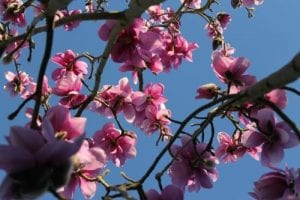
The Angiosperm phylogeny display represents the latest understanding on the evolutionary relationships and classification of flowering plants inferred from comparisons of their DNA sequences. The paths within this collection take the form of a branching tree (phylogeny) of the flowering plants beginning with the most ancient group, the basal angiosperms, from which all the other major lineages of flowering plants have diverged.
The display starts with a raised pool, home to many waterlily species, including Nymphaea odorata. Planted around the pool are other ‘basal angiosperms’, Schisandra chinensis and Kadsura japonica climb up wooden tripods, while underneath Illicium anisatum, a relative of the star anise, grows. A beautiful collection of Magnolias including: Magnolia stellata and Magnolia dolsopa flower in spring. Tender plants are plunged out during summer such as the pepper relative Macropiper nigrum - and the edible cherimoya, Annona cherimola. Some plants in this collection are too tender and must remain in the glasshouse including the most ancient basal angiosperm Amborella trichopoda. From the basal angiosperms two paths radiate out into the display. One is planted with ‘Monocots’ and includes palm, orchid, lily, grass, iris and ginger plant families. The second is planted with ‘Eudicots’ and includes poppy, buttercup, protea, geranium, daisy and pea families. A walk through the display illustrates the rich diversity of flowering plants which can be traced back to a common ancestor group. Interpretation boards give information at key positions in the display.

